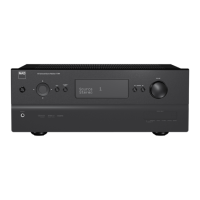NEO:6
Two-channel recordings, whether stereo or surround-encoded, are
reproduced with Neo:6 surround with output to front left/right, center and
discrete left/right surround channels plus subwoofer (assuming these are
present in the current “Speaker Conguration”). The T 747 provides two DTS
NEO:6 variations - NEO:6 Cinema and NEO:6 Music. See also section about
“ADJUSTING LISTENING MODES” below.
EARS
Two-channel recordings, whether stereo or surround-encoded, are
reproduced with proprietary NAD surround processing with output signals
to the front left/right, center and discrete left/right surround channels,
plus subwoofer (assuming these are present in the current “Speaker
Conguration”). EARS does not employ the surround back speakers (if any).
EARS extracts the natural ambience present in nearly all well-produced
stereo recordings. It does not synthesize any ambience or other sonic
elements and thus remain truer to the sound of the original musical
performance than most other music-surround options.
Select EARS for listening to stereo music recordings and broadcasts.
EARS produces a subtle but highly natural and believable ambience from
nearly all “natural-acoustic” stereo recordings. Typically, these include
classical, jazz, and folk genres as well as numerous examples from others.
Its virtues include realistic, stable “front-stage” sonic imaging and spacious
but unexaggerated ambient “virtual acoustics” that remain faithful to the
original recording.
ENHANCED STEREO
All recordings are reproduced in stereo via the maximum speaker
complement congured in the current “Speaker Conguration”. Enhanced
stereo can be useful for maximum volume from all channels or for multi-
speaker background music (cocktail party) listening. For this mode, Front,
Center, Surround and Back speakers can be turned ON/OFF as desired.
7 CH STEREO 7 CHANNEL STEREO
Two-channel recordings are reproduced with output signals to the front
left/right, center, discrete left/right surround and back surround left/right
channels, plus subwoofer (assuming these are present in the current
“Speaker Conguration”). The Back Surround (left/right) output level is -3 dB
lower than the other channels.
ANALOG BYPASS
All analog signals remain in the analog domain without analog-to-digital
conversions. At Analog Bypass, the DSP circuitry is bypassed but full tone
control functions remain. “Bass management” or “Speaker Setup” are also
not in eect as these are DSP functions.
ADJUSTING LISTENING MODES
Several of the T 747’s listening modes have one or more selectable variations
and adjustable parameters that you can modify to suit your personal
preferences. At Listening Mode menu, use a combination of the [ ] and
[ ] keys to navigate and eect desired settings.
NOTE
Listening Mode parameter changes are maintained when you change
listening modes. You may also save a modied Listening Mode for easy
recall by saving it to a Preset (See “A/V PRESETS” below under Setup
Menu discussions).
PRO LOGIC IIx
PLIIx MOVIE is optimized for lm soundtracks.
PLIIx MUSIC for music recordings.
Center Width (0 to 7): Modies the “hard-centeredness” of the center
image, by gradually mixing mono center content to the Front left/right
speakers as well. A setting of 0 retains the center-channel-only default
while a setting of 7 yields a fully phantom center channel.
Dimension (-3 to +3): Adjusts front-rear emphasis of the surround
eect independently from the relative channel levels.
Panorama (On/O): Adds a “wrap around” eect by extending some
stereo content into the surround channels.
NOTE
Pro Logic IIx mode will decode as Pro Logic II mode when the “Back”
surround speakers are set to “O” from “Speaker Congurations” menu.
Refer also to the item about “SPEAKER CONFIGURATION” under the
“SPEAKER SETUP” segment of “OPERATION – USING THE T 747 – SETUP
MENU” section.
NEO:6
NEO:6 Cinema is optimized for lm soundtracks.
NEO:6 Music for music recordings.
Center Gain (0 to 0.5): Adjust for better center image in relation to the
surround sound channels.
DSP OPTIONS
DSP Options has the feature “Lip Sync Delay” whose function is to match
any delay that may occur in the picture relative to the audio.
By varying “Lip Sync Delay” from 0ms to 120ms, one can delay the audio
output in order to synchronize it with the video image.
Another DSP option is the “HDMI Audio to TV”. This option is applicable
only when using an HDMI source and a video output display that is HDMI-
capable. “HDMI Audio to TV” setting can be set to either “On” or “O”.
On: When set to “On”, audio will be available via both the HDMI-capable
TV’s own speakers and the T 747’s speakers.
O: When set to “O”, audio will only be available via the T 747’s
speakers. There will be no audio at the HDMI-capable TV’s own speakers.
OPERATION
USING THE T 747 MAIN MENU
16
ENGLISH FRANÇAIS ESPAÑOL ITALIANO DEUTSCH NEDERLANDS SVENSKA РУССКИЙ

